Singapore: A Compelling Statement of Asia's Future with Contrasts and Challenges Along the Way
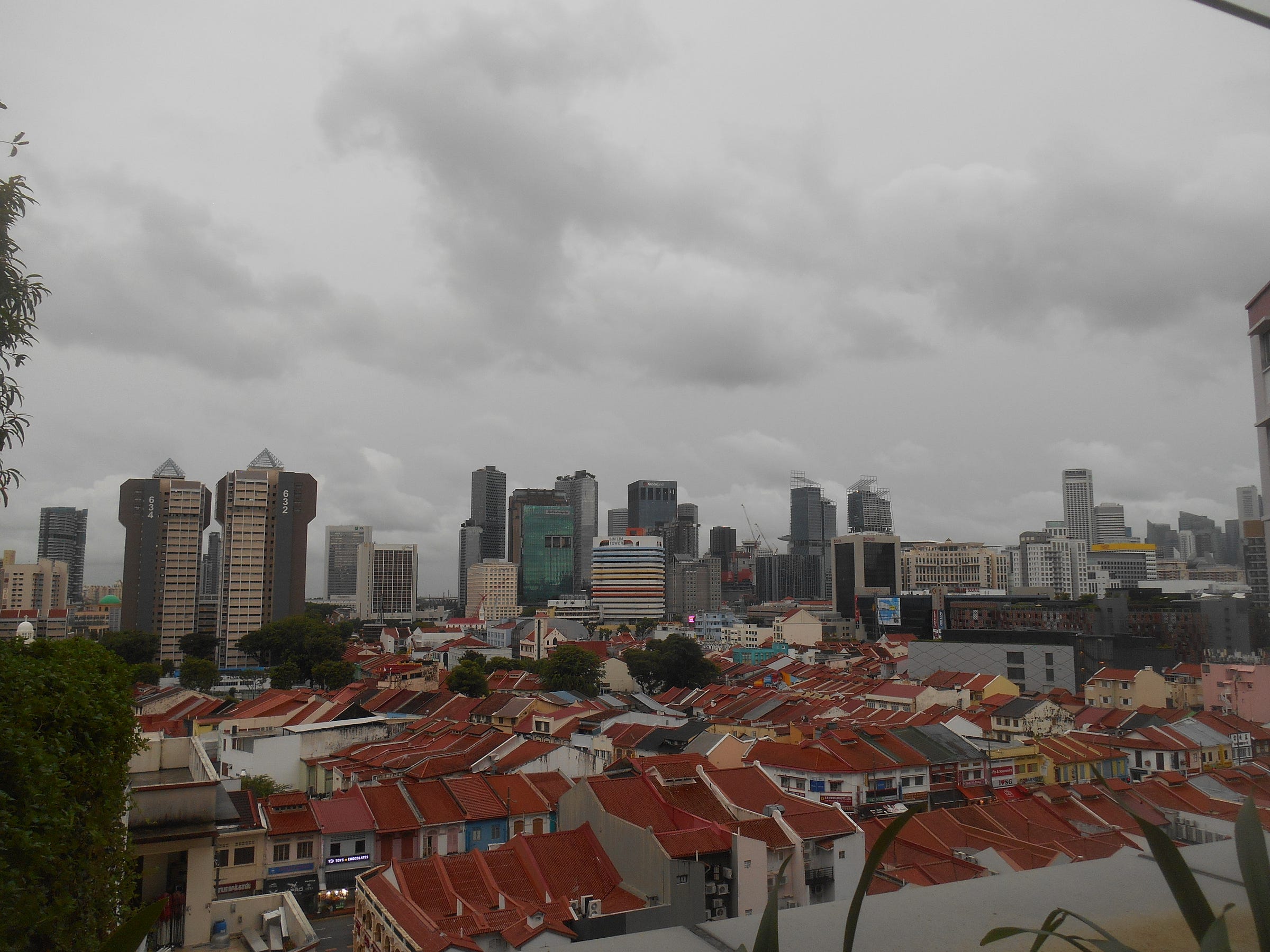
When I learned that an interesting physics conference in June 2024 was going to be held in the Republic of Singapore, I knew immediately that I needed to be there. Aside from my professional reasons to go, on a personal level I knew that the stature of Asia over the last several decades, with a vibrant and diverse population of hard-working and well-educated people from all walks of life, was something I needed to experience more.
Among the various regions worldwide where I ventured as a theoretical physicist, Asia was often neglected as a travel destination compared to Europe or North America. As a seasoned world traveller, this was a personal disappointment of mine because it’s been decades since I had first visited the continent. As noted above, I’ve always been fascinated by its multiplicity of rich cultures, delicious food to enjoy, and basic quality-of-life encounters I always want to experience whenever I travel to a new place on Earth.
Singapore has been a particular fascination of mine for a very long time. Formerly a part of Malaysia until it became an independent city-state in 1965, this island’s legacy as a one-time British colony situated in a geographically strategic region for trade and interchange is something to take very seriously. From 1942 to 1945, the Japanese occupying forces during World War II were very conscious in ensuring that Singapore was under its control precisely because of its convenient location on the Malay Peninsula as a major port city to receive oil shipments from the Suez Canal in the Middle East. It served as a convenient access point via the Malacca Strait for the distribution of goods throughout the archipelagos of Malaysia to the north, Indonesia to the south, The Philippines to the east, and other very populated regions in southeast Asia.
The fact that today’s Singapore, with a population of six million people and counting, is one of the richest regions of the world per capita—despite having virtually no natural resources of its own to export—is something that you can’t fully appreciate until you see it for yourself. How is that even possible? Even after returning from my trip and thinking intently upon the myriad of impressive sights and achievements I observed while being there, I know that there’s still a lot more to Singapore than meets the eye. Certainly, a week-long visit to the city while occupied all day by an academic conference at its flagship university is hardly any time for me to gain a full sense of what Singapore is all about. Nonetheless, I did my best to get as much as I could out of the whole travel experience.
Besides the professional and travel-related reasons for wanting to go to Singapore, I also had a very personal reason for going in that two long-time friends of mine, an artistic married couple named Vincent and Leng, had moved there from Canada over 25 years ago. This trip would be the first time that I had a chance to see them again after so many years. Despite the fact that I wouldn’t actually get to see them together because of their own individual travelling to Malaysia and Indonesia for personal and professional reasons, respectively, I was very grateful to at least see them separately during the week and make the most of my time to reconnect after so many years of disconnection.
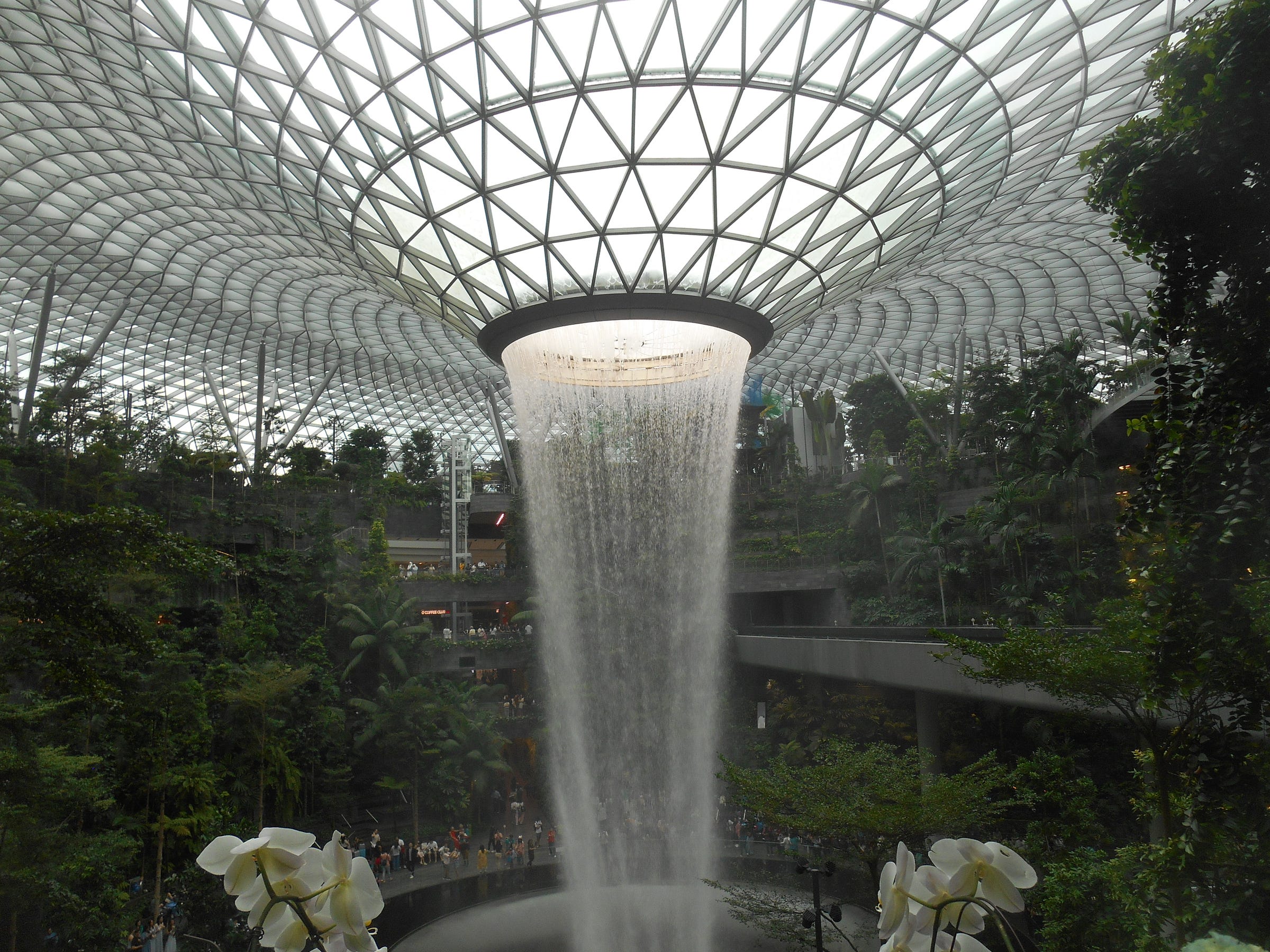
Singapore’s Changi Airport—Is it Really the Best Airport in the World?
Given the large number of airports worldwide that I’ve experienced in my travels, it’s genuinely astonishing to discover that many Singaporeans often spend their weekends at their main airport with absolutely no travel-related reasons to do so. Although I’ve had my share of very pleasant—and also not-so-pleasant—experiences in airports throughout the years, none of them would even remotely qualify as a destination to visit for its own sake. Remarkably, I got to see for myself why it’s not such a crazy idea to consider Singapore’s Changi Airport (https://www.changiairport.com/) as a tourist destination in its own right, or why it’s been consistently voted by Skytrax as the world’s best airport for at least the past 12 years, according to travel industry experts.
After leaving Vancouver for a 16-hour direct flight at just past midnight, I arrived at Changi Airport’s Terminal 2 in the early morning on Saturday just in time to have some breakfast at one of its many restaurants catering to both Asian and western cuisines. Since I had several hours between my arrival and check-in at the first of four hotels where I planned stay during the week, I had a unique opportunity to explore as much as I could about Changi Airport for a first-hand experience before finally venturing into the city for the first time. It also helped that I was able to sleep on the plane, so I was fully alert upon my arrival to do just that.
My first impression of Changi Airport is that it’s immaculately clean and well-organized, a recurring theme that’s constantly reinforced throughout my entire stay in Singapore. As a major hub for international travel to Asia, Changi Airport receives between 30 and 70 million people annually. That’s an astounding number equal to roughly five to ten times the entire population of Singapore! Besides the fact that the gates are all carpeted which I didn’t expect to see, passing through security to reach the arrivals section was a very smooth process. A big reason why is because the Singapore Government requires all visitors to complete an SG Arrival Card (https://eservices.ica.gov.sg/sgarrivalcard/) application about two to three days prior to their intended arrival date . Not doing so in advance often leads to unforeseen difficulties for visitors without this documentation in hand, so it’s important to follow the process as instructed.
It probably took about 15 minutes at most for me to pass through security and reach the arrivals section where checked luggage is picked up before moving on with the rest of the day, something I didn’t need to worry about because I came with only one carry-on and a small backpack. Since I had at least six hours available at Changi Airport to simply pass away the time, I decided to approach an information desk to get some tourist brochures and pay for a three-day all-inclusive public transit pass for both Singapore’s extensive bus and Mass Rapid Transit (MRT) system.
While the pass is likely a good deal for tourists who plan to visit a lot of destinations within the three-day period, in retrospect I would have been better off not buying it, since I soon learned that I could use my credit card as instant payment at the gate for my more limited travel needs, not unlike when using the London Underground. As such, the cost of individualized travel was actually much cheaper than what I anticipated, so buying the travel card was a waste of money for what I needed.
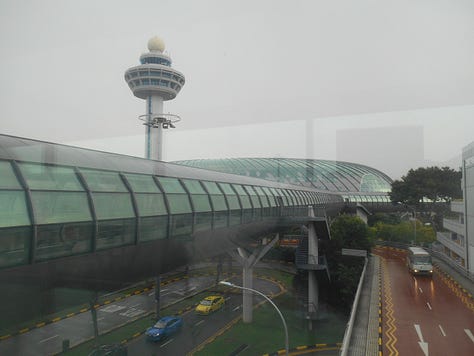
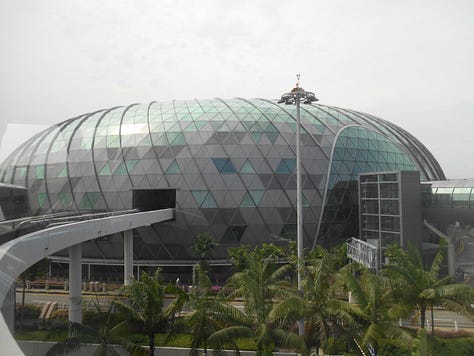
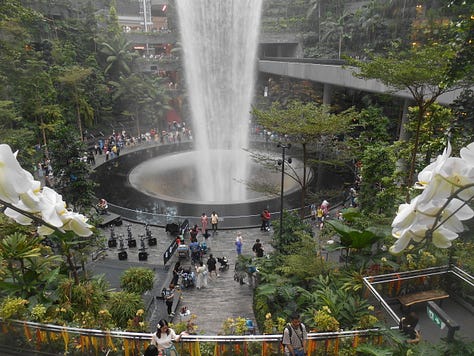
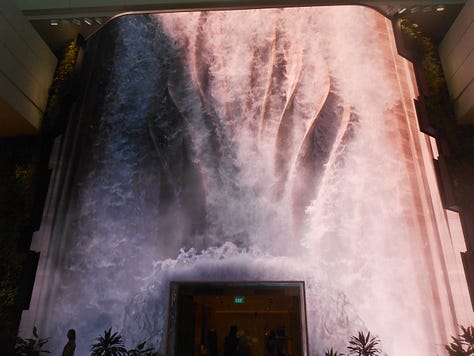
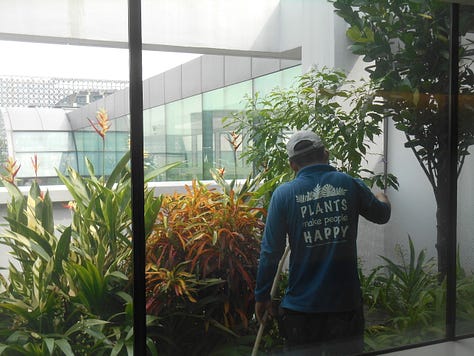
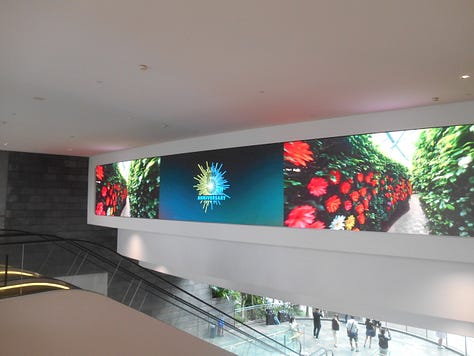
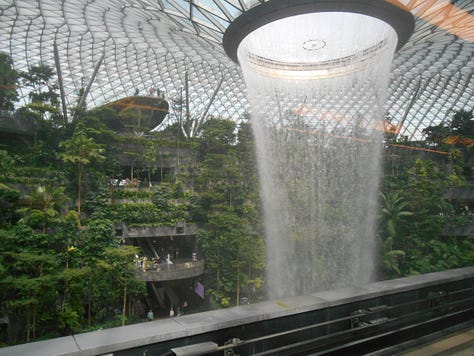
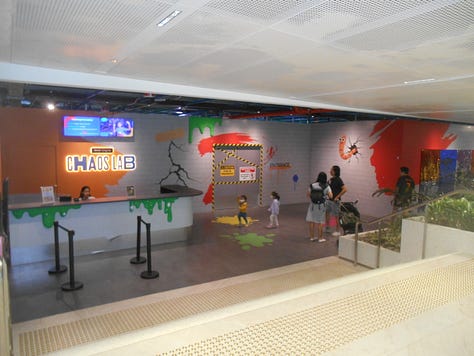
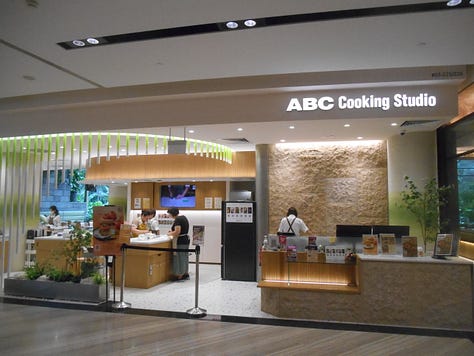
To give a proper account of Changi Airport and all that it offers for visitors and Singaporean residents would amount to writing a separate article, so everything written below doesn’t remotely do justice to cover all that is available to see and do there. Changi Airport has a very efficient light rail system that connects together Terminals 1, 2, and 3, while a regular bus connects passengers to Terminal 4. An absolute must-see destination that understandably draws the most inspiration for visitors is the aptly named Jewel located between Terminals 1 and 3. Jewel was designed by famed Israeli-born and Canadian-educated architect, Moshe Safdie, whose construction was completed in 2019. He was also the lead architect for the signature Marina Bay Sands hotel and surrounding complex built in 2010 that I’ll comment about later.
Without doubt, the signature feature to be found in Jewel is the Rain Vortex, a 130 foot (40 metre) indoor waterfall that to date is the world’s tallest of its kind. Surrounded by an extensive multi-tiered botanical garden throughout the space, this waterfall runs daily from 11:00 am to 10:00 pm and uses recycled rain water. The interwoven sense of experiencing a tropical rainforest environment while encased within an ultra-modern structure like Jewel—all embedded within a functioning international airport—is something that continues to provide inspiration whenever I think about the experience.
Despite the numerous photos and videos available on-line to showcase the magnificence of what I encountered in Jewel, they simply don’t compare to what comes from a first-hand encounter. It’s no wonder why, for example, many newlywed Singaporean couples choose to have their wedding photos taken near the Rain Vortex, or why others engage in regular exercise programs that are offered in the open space. The fact that it’s possible to have a close-up view of the waterfall by taking the sky train that passes through the interior of Jewel while connecting between Terminals 1 and 3 is truly something to behold and requires a first-person experience to fully appreciate.
Besides serving as a meeting place with extensive gardens and refreshing water from the indoor waterfall and surrounding pool, Changi Airport as a whole also serves as a major shopping mall and community centre. For example, Singaporeans and visitors can take cooking lessons, sample the wide variety of cuisine in its food court, go to a children’s playground and have wild fun speeding down a four-storey high amusement slide, watch the latest scenes in a full-sized movie theatre, or even take a swim between flights!
While I can’t say for sure if Changi Airport is indeed the world’s best as claimed by Skytrax, what I can say is that it’s undoubtedly the best airport I’ve ever been in my life—and I can’t think of one that even remotely compares to what’s offered there!
Meeting a Long-Time Friend and First Impressions of Life in Singapore
Once it was time to finally leave Changi Airport and eventually meet up with Vincent for the first time in decades, I set about to take the MRT straight to my first hotel in Chinatown to check-in and have a few hours of sleep until evening. When Vincent showed up in the lobby to greet me, we took a short walk to Boat Quay, a long and lively promenade in the heart of Singapore where numerous international restaurants of all cuisines and price points are to be found there. After taking a seriously long time to figure out what we wanted to eat, we decided upon an attractive Turkish place called Sahara Bar & Restaurant, 58 Boat Quay, Singapore 049847 (https://saharabarrestaurant.oddle.me/en_SG/) and proceeded to find seating in an air-conditioned room instead of eating outside.
While waiting for our meals to arrive, Vincent and I took the time to both get caught up on our personal lives and also talk at length about regular life in Singapore for him and his family. Besides the fact that Vincent and Leng are happy and very much settled as a permanent resident and citizen of Singapore, respectively, he told me that day-to-day life is hectic. People within their circle of friends are often preoccupied with their own interests to such an extent that it’s often difficult to get together at times. This by itself is not that unusual for a major city-state with a large population like Singapore.
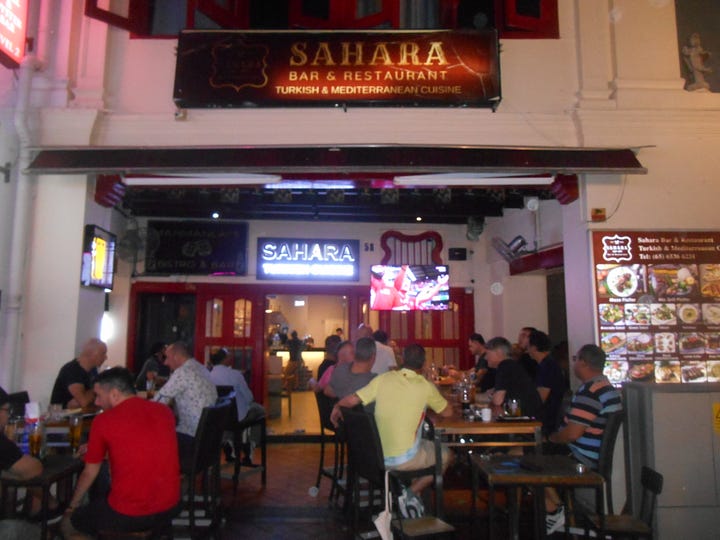
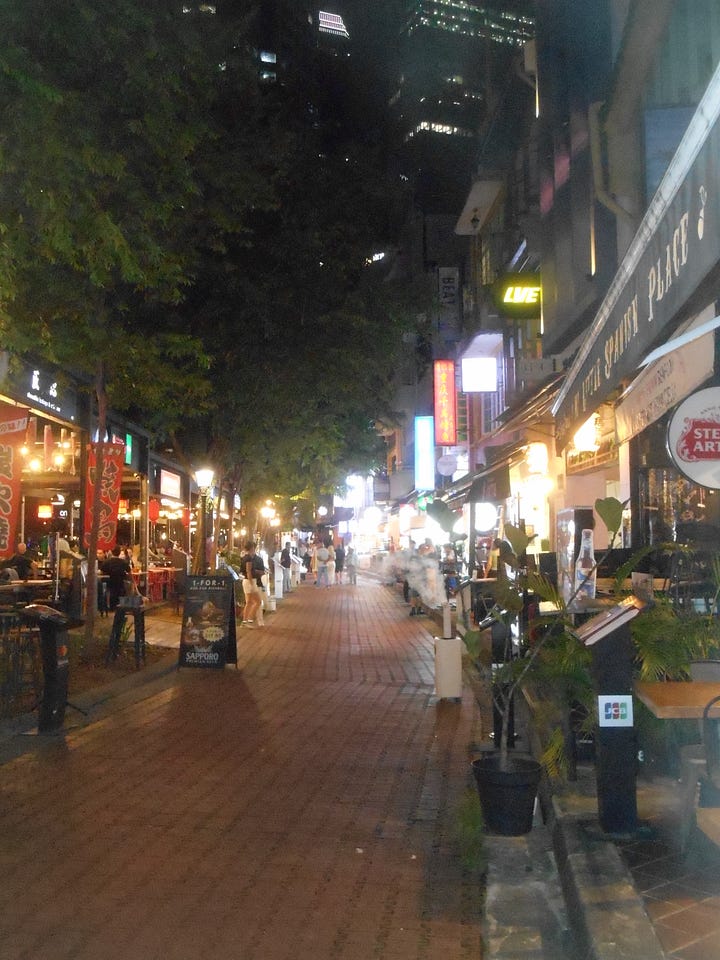


The perplexing part for me, though, is that by geography it occupies significantly less surface area than greater London and with an incredibly modern and efficient public transportation system, so getting around to different locations within its confines is incredibly straightforward. This means that the difficulties encountered in connecting with friends have little to do with the basic mechanics of ground transportation. Regarding how to get around, what I learned is that despite the abundance of private cars all over the streets of Singapore, most of the population use public transit because owning a vehicle is prohibitively expensive with all sorts of taxes and permit fees to cover, plus the high cost of fuel to operate it regularly. Personally, if I were a resident of Singapore I’d be quite comfortable not owning a car to get around because the city-state is structured in a way that makes it possible to get by easily without one.
As a first-time visitor, it took me roughly half-a-day to become comfortable in knowing where I was going and how fast it would take for me to reach any major location within Singapore. While English is the de facto main language used by all Singaporeans to communicate with each other, there are actually four official languages in total. The other three languages are Mandarin Chinese, Malay, and Tamil, each reflecting the rich multi-ethnic composition of Singaporeans living together over successive generations.
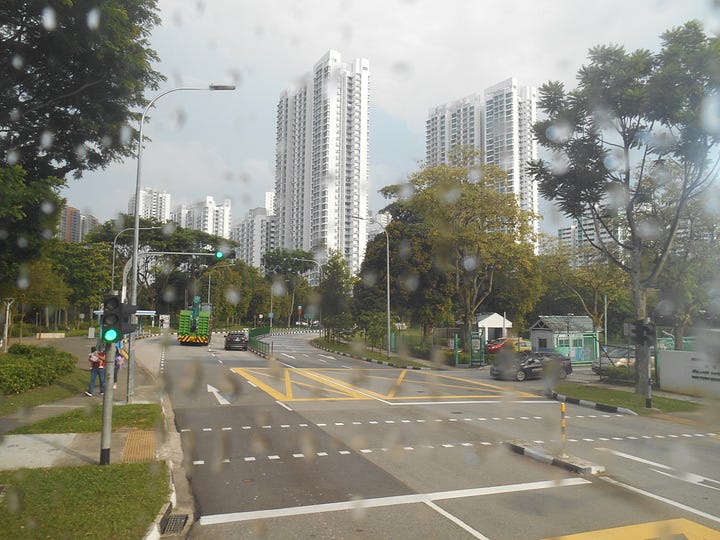
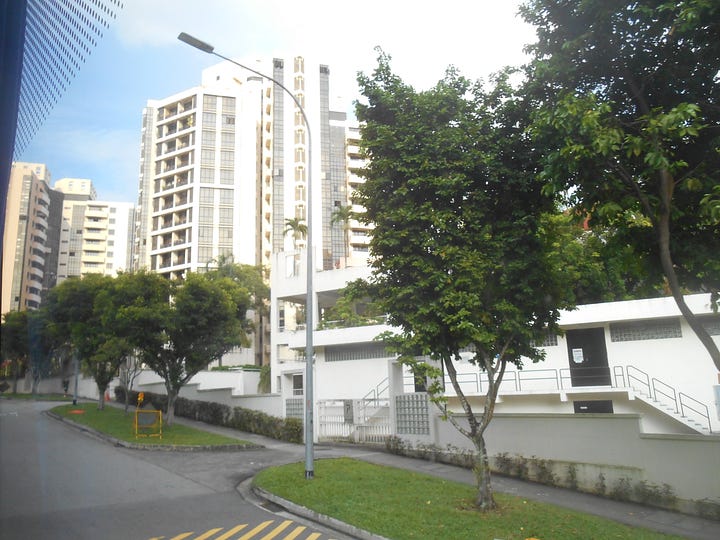
One thing that Vincent told me over dinner was that, despite already having limited space to contain its current population, the Singapore Government is committed to increasing its population to 9 million people! When I asked him how it could possibly do that without major problems to occur, he pointed straight upwards to denote the massive expansion of government-owned public housing complexes called HDBs—in reference to the government’s Housing and Development Board—found all over Singapore wherever land is available for construction. Some 80% of Singapore’s entire population lives in an HDB, including Vincent and Leng, their school-aged daughter, a live-in assistant, and Leng’s elderly parents in one self-contained unit. While they and other Singaporeans don’t technically own their suites outright, they’re given 99-year leases by the government, so in practical terms they have very stable long-term housing available to them.
Singapore Botanic Gardens: An Oasis of Tropical Beauty in the Heart of an Expanding City of the Future
Before the conference was to begin on Monday morning, I made a point of visiting the Singapore Botanic Gardens on Sunday and get the most out of my going there for the better part of the day. Located at 1 Cluny Road, Singapore 259569 (https://www.nparks.gov.sg/sbg/), this is a very popular destination for both Singaporeans and international visitors like myself. It’s open from 5:00 am to midnight every night and—apart from one special exception to be noted later—the Singapore Botanic Gardens is free admission for anyone who wishes to visit.
While it would be clearly wrong to suggest that the Singapore Botanic Gardens is the only source of natural beauty to be found within a region smaller than that of New York City, given Singapore’s ambitious efforts to expand its current population by 50%, it’s easy to recognize that efforts to protect its natural beauty while under the pressure to rapidly urbanize is a serious challenge. Because of its past expansion efforts, Singapore has lost close to 95% of its natural forests, though now there’s a concerted effort to protect some 10% of its remaining undeveloped land available for its natural wildlife, forests, and fauna. As Singapore’s first UNESCO World Heritage Site and the only tropical garden in the world to be designated as such by the United Nations, the Singapore Botanic Gardens is most definitely a sanctuary intended to reflect the surrounding city-state’s original setting, while still having some modern touches to be found within.
Originally founded in 1869, this botanic garden is frequently visited by Singaporeans on the weekends. After taking the MRT from my hotel to the aptly named station called “Botanic Gardens,” I was able to pass through the large gated entrance way with a wild chicken to greet me upon arrival and partake of the tropical scenery. With incredibly clean paved walkways and lots of open spaces available to walk upon, it was very easy to spot large numbers of families and others sitting under the shade of large trees to have a picnic or just lie down to have a comfortable nap outside.
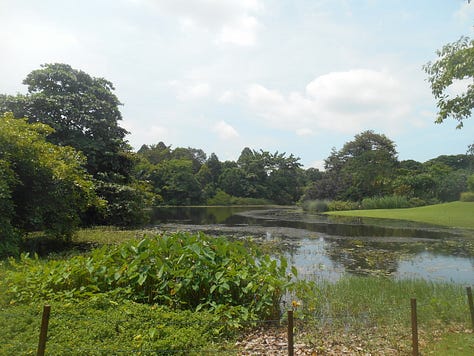

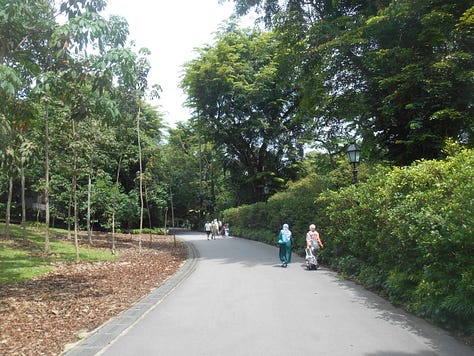
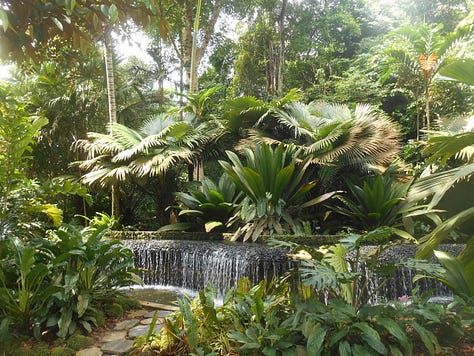
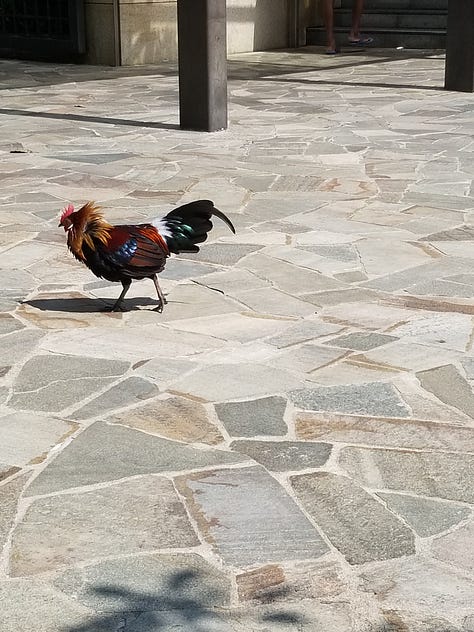
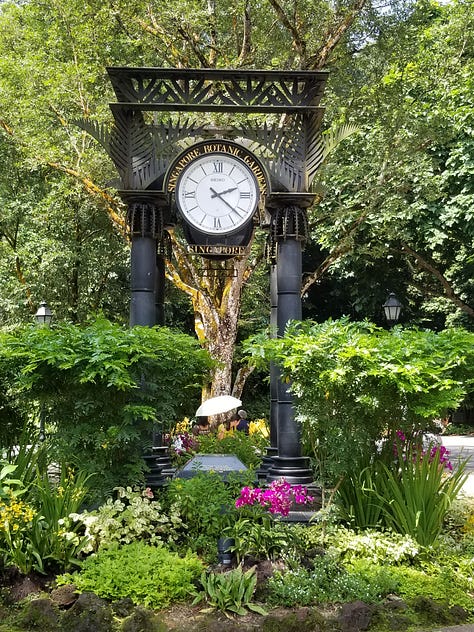
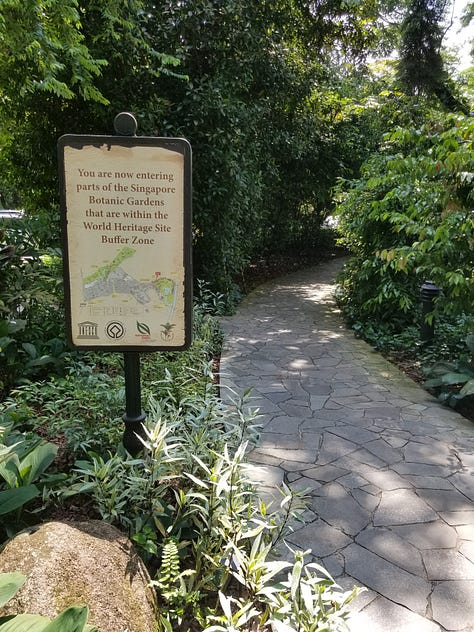
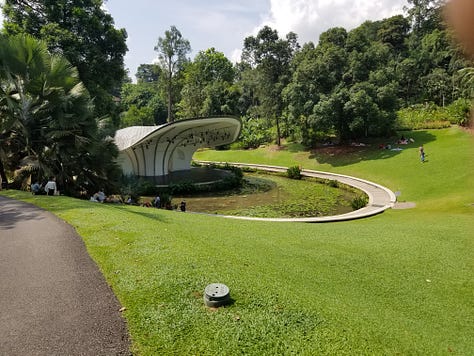

With an area of 202 acres (82 hectares), a visitor can easily spend the entire day wandering around to see and experience everything that the Singapore Botanic Gardens has to offer. Unfortunately, I didn’t have the luxury of time to take in a lazy morning and afternoon, so I had to confine myself to its northern half bounded by Cluny Park Road where I passed by its Symphony Lake and the sound stage contained within. I then headed towards Orchid Plaza where a signature exhibit called the National Orchid Garden is situated.
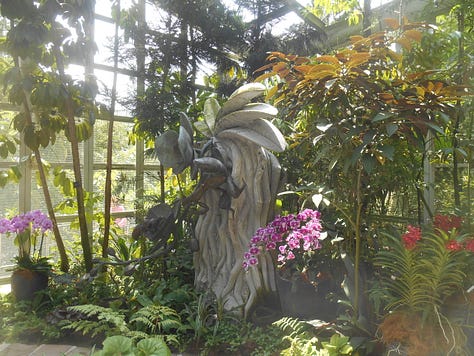
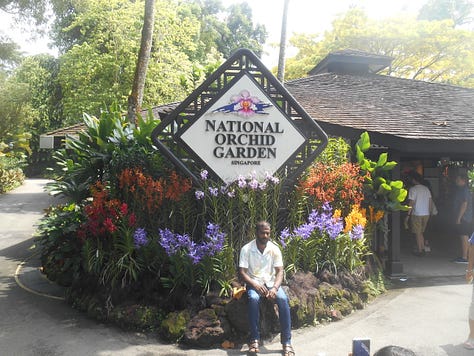

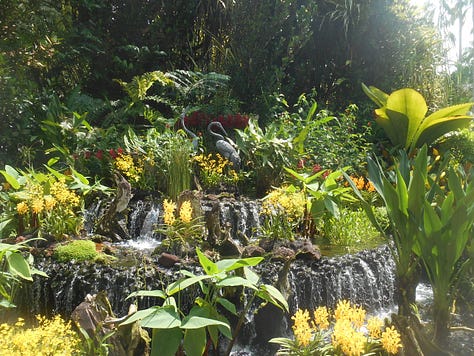
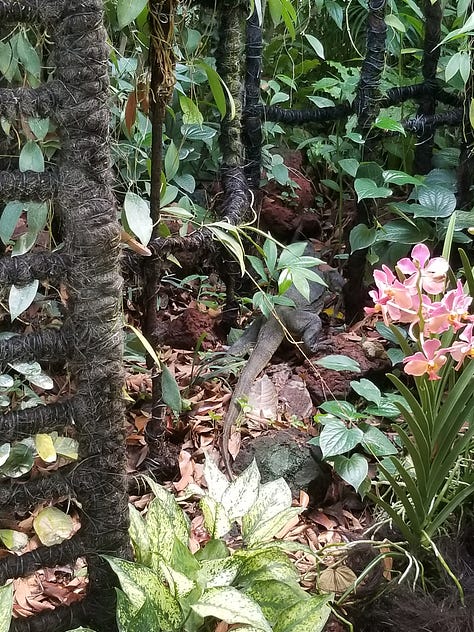
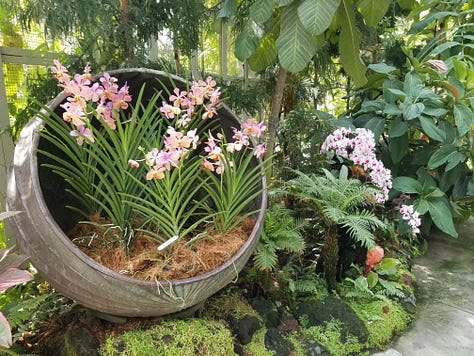
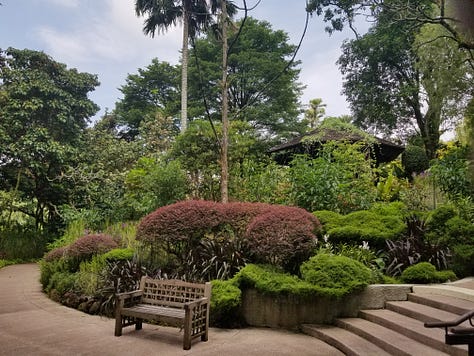
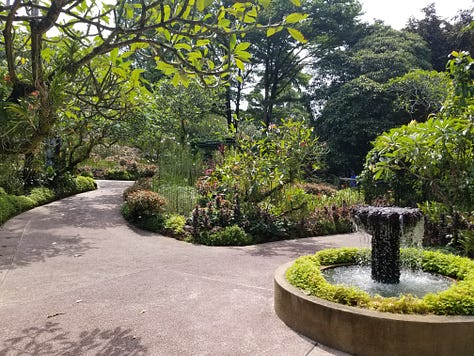

The National Orchid Garden is the only location within the Singapore Botanic Gardens that requires an entrance fee to experience first-hand. Because I wanted to take in as much as I could from what time I had available, I naturally decided to pay for an adult ticket and go inside. What I got to witness was a magnificent display of numerous and mesmerizing species of orchids in various display settings, some of which were specially cultivated and named after famous people worldwide. In addition, I got to unexpectedly witness up close some of the natural wildlife when a lizard as long as my arm casually crossed my path and walked straight into the deep bushes as if it owned the place!

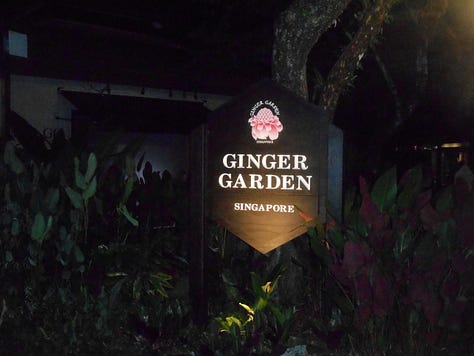
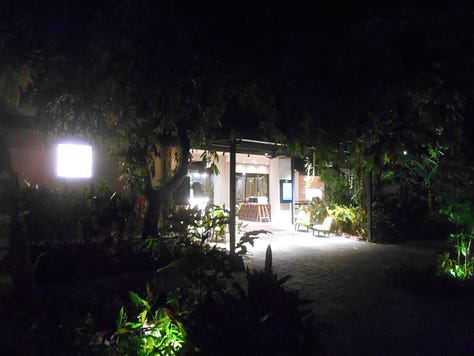
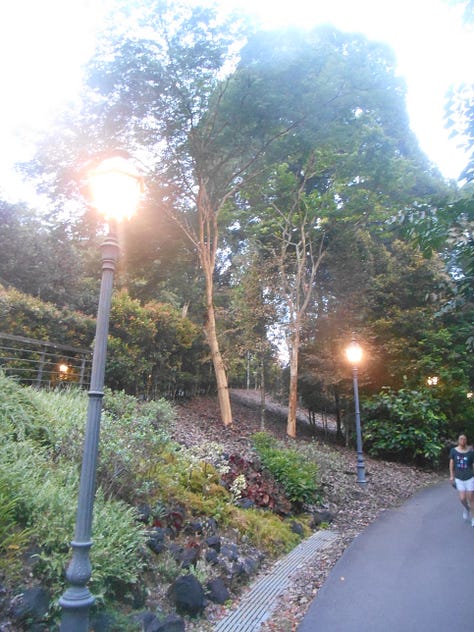

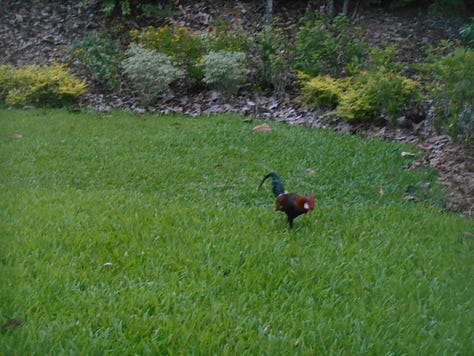
On Wednesday, I had the opportunity to visit the Singapore Botanic Gardens for a second time to attend the evening conference banquet held at The Villa (https://www.thevillasbg.com/), a signature restaurant intended for weddings and large group events and located inside a larger space called Ginger Garden that’s adjacent to the National Orchid Garden. Besides enjoying the excellent and abundant food served at the restaurant, one of my most memorable times that evening was when I walked the 15 minutes back to the MRT entrance and was immersed with the loud sounds of the forest caused by numerous tropical animals of all imagination, all of whom managed to keep themselves hidden from sight as I walked my way in the night, with lighted walkways to guide me back to the main entrance.
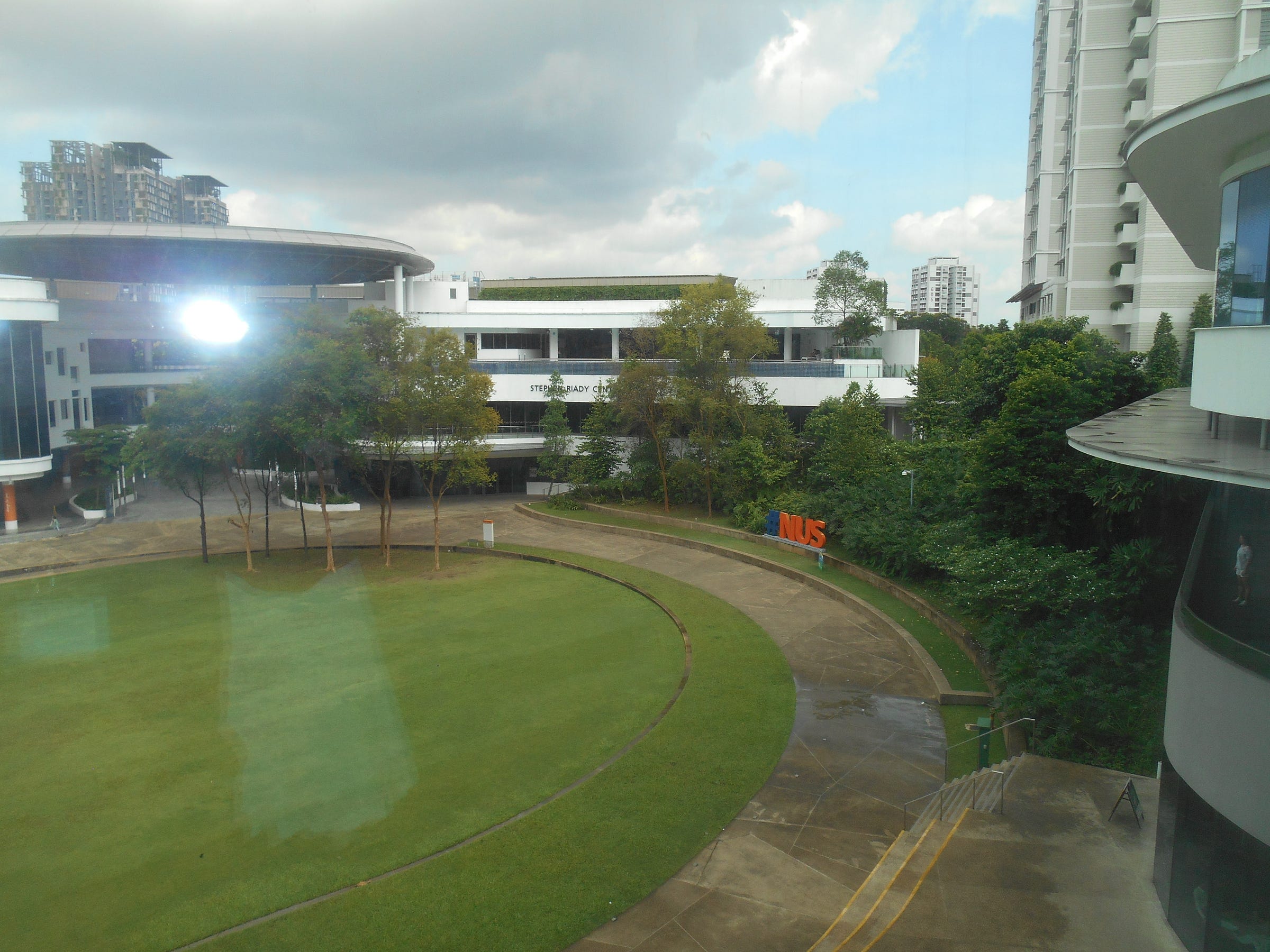
National University of Singapore
Since my main purpose for travel to Singapore was to attend a physics conference at the National University of Singapore (NUS) (https://www.nus.edu.sg/), naturally most of my day was spent on its main campus comprising of roughly 35,000 students (27,000 undergraduate and 8000 graduate-level) and 2500 academic staff. Besides having satellite campuses within Singapore which specialize in medicine, law, and public policy studies, NUS has more than 23 overseas colleges in partnership with other academic institutions throughout the world.
Founded as a small medical school under a different name in 1905, it eventually grew to become Nanyang University in 1955, a privately-funded Chinese institution. At the same time, the Singapore campus of the University of Malaya became its own autonomous institution known as the University of Singapore in 1962, just a few years before Singapore gained independence from Malaysia. Eventually, these two institutions merged in 1980 to now become NUS and operate as the city-state’s flagship academic institution. Currently, NUS has the high ambition to serve as a “vital community of academics, researcher, staff, students, and alumni working together in a spirit of innovation and enterprise for a better world,” and with a dedication to “service of country and society.”
At the nearby luxury hotel where most of the conference participants and I stayed, we took a charter bus to and from NUS each day, while the others who stayed elsewhere found their way to campus using the very efficient MRT noted earlier. As to be expected, NUS has state-of-the-art facilities for hosting lectures and public gatherings, including a large green space in the midst of its campus buildings for personal recreation. As well, its extensive food court has a wide variety of cuisines available for its campus community with high-speed internet access points located everywhere for students and others who need to do their computer work in the common areas.
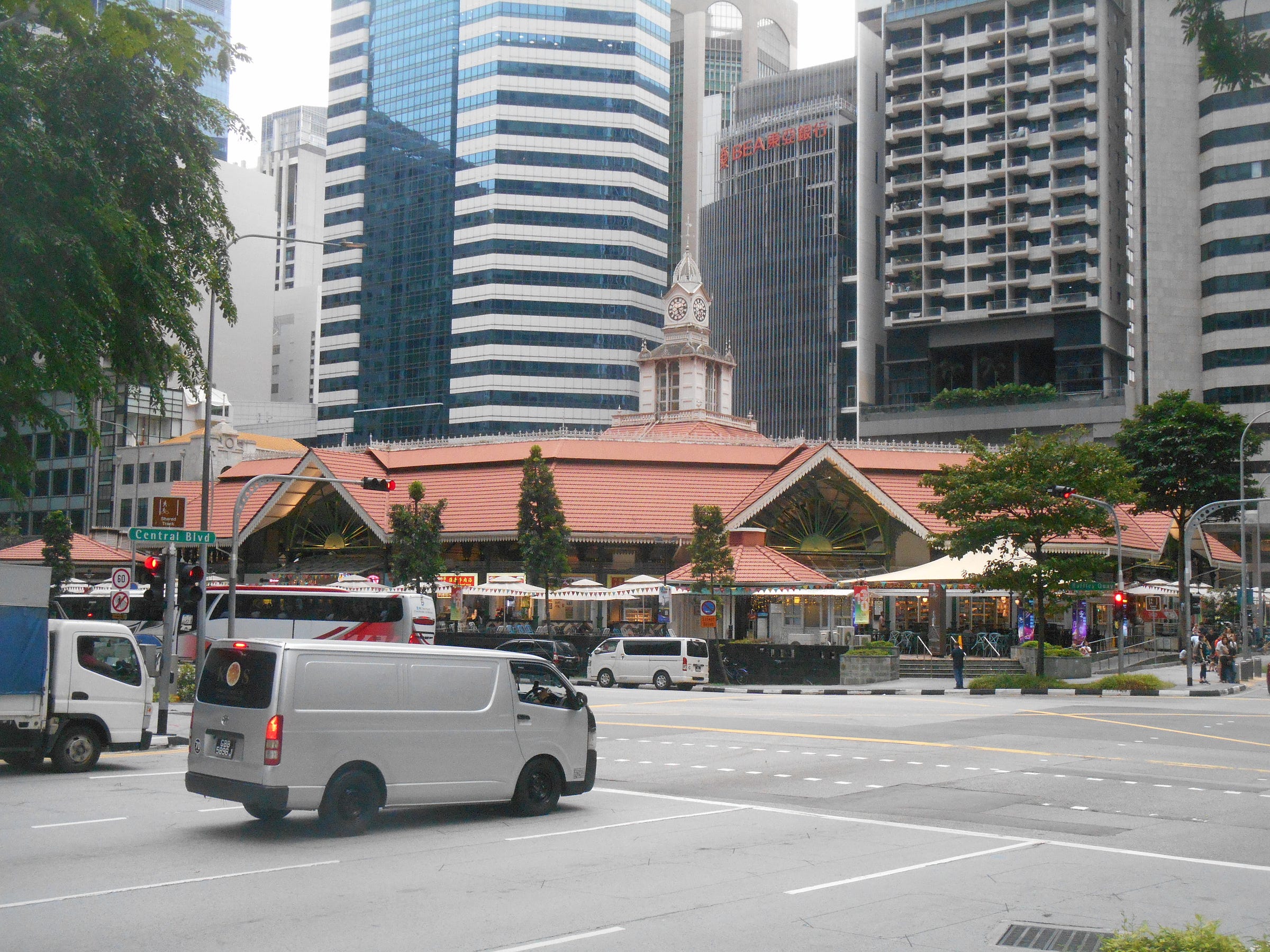
Exploring the Richness of the Food Culture in Singapore
One thing I learned very quickly while in Singapore is that its food culture is vast in scope and incredibly rich. It’s no secret that some of the finest restaurants in the world are located in Singapore. At the same time, it’s also very easy to find high-quality food to eat that’s very budget-friendly. To do that, you need to look out for the many open food courts in Singapore that are known as hawker centres, named after the original roaming food vendors of decades’ past who would set up temporary vending sites on the street. The Singapore Government would eventually centralize these kiosks in the late 1960s to form standalone communal centres with all varieties of food offered to local neighbourhood people. Throughout the world, today’s food courts in shopping malls are the modern-day equivalent of what these hawker centres were back then.
As noted earlier, there are numerous hawker centres throughout Singapore, with many more to be formed with the city-state’s expansion. Some of the well-established ones are the Maxwell Food Centre and Chinatown Complex in the Chinatown region, while the Tekka Centre is found in Little India, and the Newton Food Centre is in the city-state’s outskirts. It’s interesting to note that there exist actual Singapore food tours (https://www.viator.com/en-CA/Singapore-tours/Food-Tours/d18-g6-c80/) available for visitors who want to sample the wide range of cuisines available to experience.
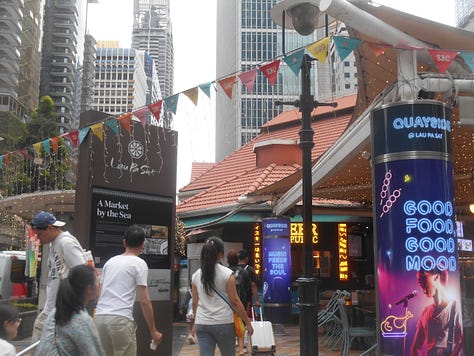
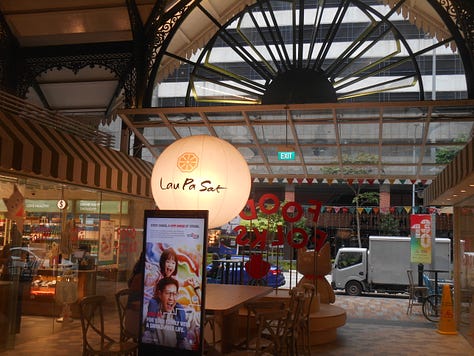
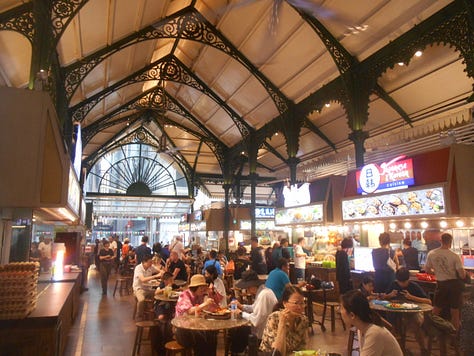
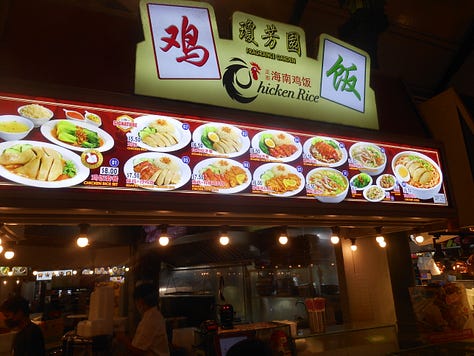


On Saturday evening before my flight home the next morning, I went to Lau Pa Sat (https://www.laupasat.sg/) on 18 Raffles Quay, Singapore 048582, which is the oldest of the hawker centres in Singapore. Formed in 1824 as a fish market, its name literally means “old market” in Chinese and was constructed with a cast-iron frame in the Victorian style of architecture. There were literally too many enticing food options from which to choose, but I decided upon having Singapore’s national dish of Haianese chicken rice to eat as a simple and inexpensive yet satisfying meal while there. Perhaps on a future visit to Singapore, I may try several more options at Lau Pa Sat or any of the other hawker centres to be found!
For an interesting contrast, on Tuesday evening Vincent invited me over to his home for supper before he left for a scheduled trip to Indonesia, in which I had a chance to experience for myself what regular life is like for Singaporeans who live in an HDB. On a practical level, the suite that he, Leng, and her parents share is quite spacious and comfortable with no difficulty to prepare a home-cooked meal. I was pleasantly surprised with this discovery, given my first impression of Singapore as a heavily populated city-state in a relatively small area for which regular use of hawker centres is the norm for most of the population.
Another interesting surprise for me was that for supper we ate salmon imported from Norway, though really it shouldn’t be given the wide variety of international foods available at the ready. Since Singapore needs to import most of its food from elsewhere to function, the fact that it derives a major source of its revenue through shipping and trading to other regions in Asia means that it has the capacity to acquire food from literally all over the world—and do it relatively easily regardless of its tropical location. Irrespective of that point, I enjoyed both the food and the company for this personal visit I had.
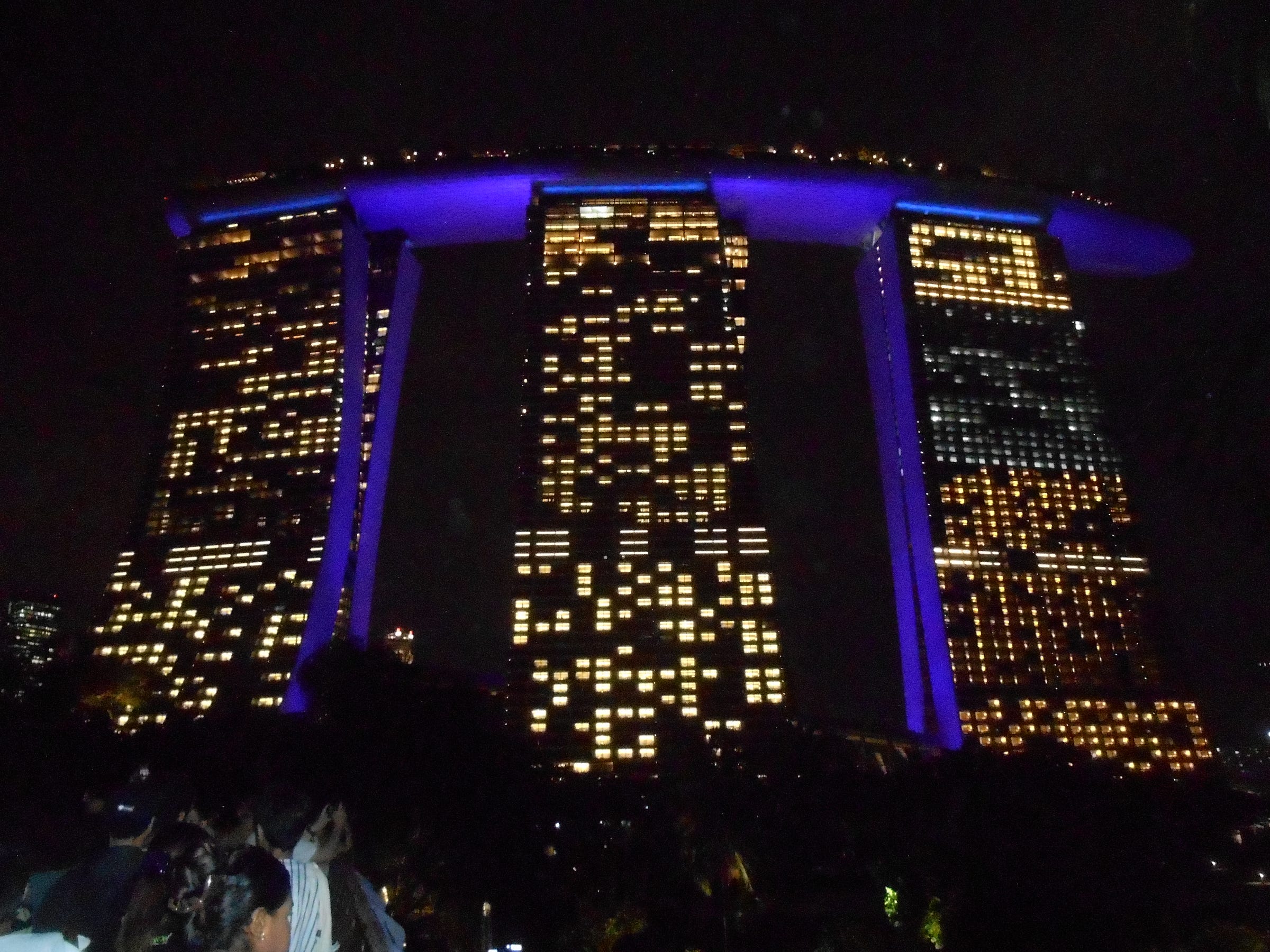
The Marina Bay Sands and Singapore Alive at Night
I simply couldn’t travel all the way to Singapore and not take a moment to visit the scenic and very wealthy Marina Bay area where the signature three-tower skyscraper hotel called the Marina Bay Sands (https://www.marinabaysands.com/) highlights the modern skyline of Singapore. Located at 10 Bayfront Ave, Singapore 018956, in actuality the Marina Bay Sands is more of an integrated and self-contained resort complex that’s 38.3 acres (15.5 hectares) in total area, including a casino, shopping mall, museum, full-sized theatre, multiple high-end restaurants, and the world’s highest infinity pool that connects together the three towers. This centrepiece 57-storey hotel, with a total height of 627 feet (191 metres) above ground that has close to 3000 guest rooms, is by far the tallest one that I’ve ever seen in my entire life!
On Thursday evening immediately after the conference ended for the day, I proceeded to go to one of its high-end restaurants called Cé La Vi (https://www.celavi.com/en/singapore/) situated on the 57th floor of Tower 3 (1 Bayfront Avenue Marina Bay Sands, Hotel, Tower 3, Singapore 018971) and adjacent to the infinity pool. I had to make an advance reservation not only to make sure to have seating for dinner, but also to gain access to the hotel’s observation deck on the roof without requiring a separate entry ticket. As well, I needed to make the reservation late enough at night in order to partake of a popular evening event held at ground level near the hotel.
By this, I’m referrring to the much-celebrated light show held every night at 7:45 pm and 8:45 pm at the nearby Gardens by the Bay (https://www.gardensbythebay.com.sg/) attracting thousands of people to immerse themselves with the multimedia experience at ground-level for free, or pay for the option to watch the event from above while walking a skyway connecting together the 18 multi-coloured “supertrees” standing at 164 feet (50 metres) above ground. While I clearly had no time to do the skyway walk, I definitely wanted the light show experience both at ground-level, and while at the Marina Bay Sands observation deck to see it from above. Therefore, I made sure to arrive well before the 7:45 pm show, so that I may be among the visitors at ground-level to marvel at the spectacle of what I was about to witness for the first time.
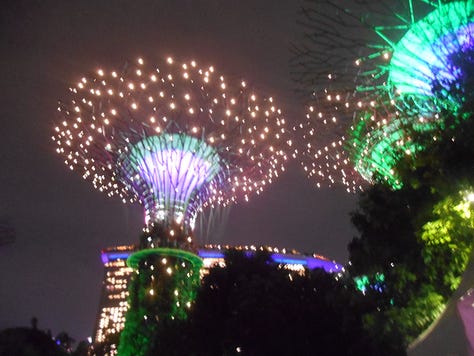
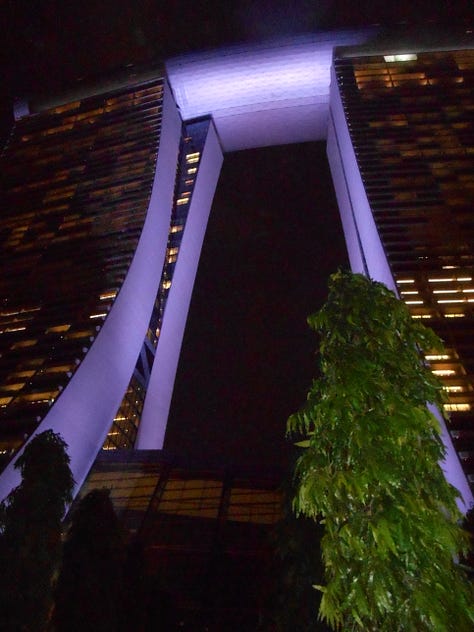
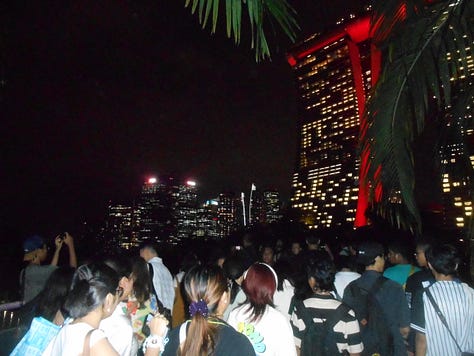
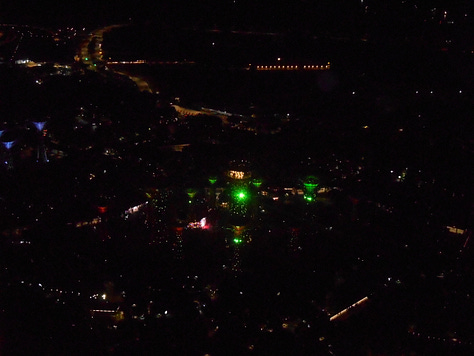
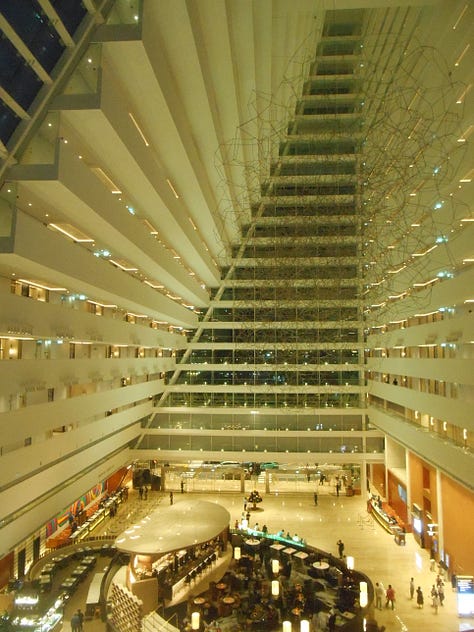
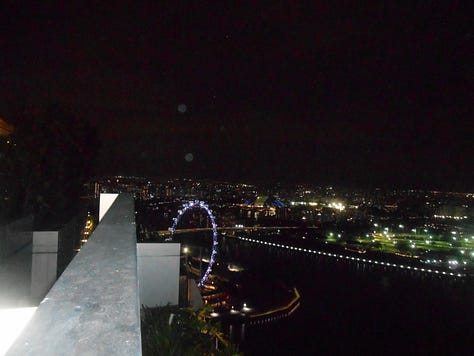
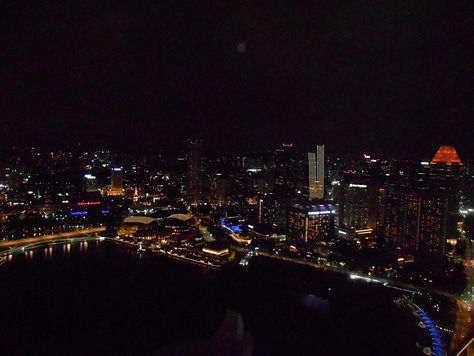
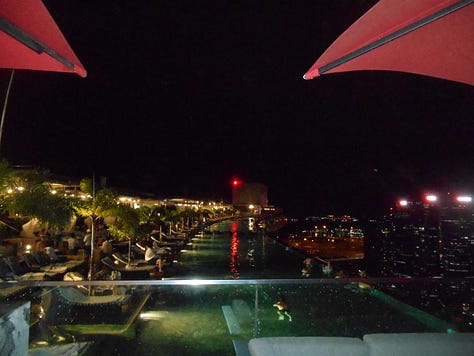
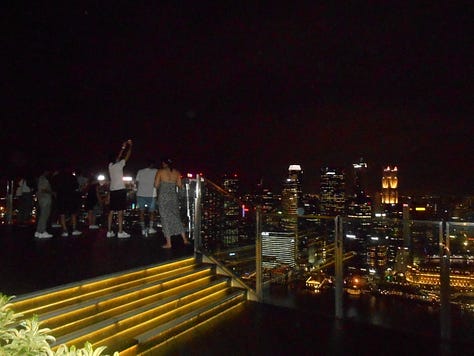
After finishing with the light show, I walked quickly to the main entrance of the Marina Bay Sands to eventually make it inside. Upon my arrival, I couldn’t help but admire the sloping concave structure from the ground up towards the infinity pool on the top floor. As well, I knew that from an architectural standpoint this hotel had to be well-designed to withstand typhoon-force winds and other serious weather and environmental stresses that are to be found in Singapore. It wasn’t until after my return home that I discovered just how significant of an engineering problem it was to get the hotel and complex built in the first place.
The vision for the Marina Bay Sands began in the early 2000s when the Singapore Government sent out a call for bids to construct a resort to satisfy Singapore’s tourism and economic objectives for the next several years. In 2006, Las Vegas Sands (LVS) Corporation (https://www.sands.com/) headed by CEO Sheldon Adelson won the bid to construct the project, something that he said was “by far the largest and most expensive single project we’ve ever undertaken.” With an initial budget of 5 to 5.5 billion USD, the project would eventually cost LVS about 8.8 billion USD, in which it suffered a brief crisis during the 2008 worldwide financial collapse. Eventually, however, with an emergency investment from Adelson’s personal net worth to cover the shortfall until the crisis was averted, the Marina Bay Sands was finally completed in 2010 to worldwide acclaim.
LVS hired world-renowned lead architect, Moshe Safdie, (https://www.safdiearchitects.com/) to design the entire complex. An innovative architect from Israel and educated in Canada at the McGill University School of Architecture, Safdie already became famous as a student for his ground-breaking design of Habitat 67 at Expo ’67 in Montreal and, as noted earlier, would eventually design Jewel Changi Airport several years afterwards, with its completion in 2019. As an architect known “for his use of dramatic curves and geometric patterns,” this project at the time would be “his largest and most difficult” one to complete in his career.
The technical challenges that Safdie and the engineering teams faced in the timely completion of the Marina Bay Sands were enormous, mostly due to the fact that the reclaimed Marina Bay upon which the construction would appear has a seabed covered with marine clay. This substance is very soft with poor natural qualities to support the full weight of the complex without a lot of careful planning and implementation to ensure structural stability. The fact that they were able to figure out every design and structural element required—including the use of high tension steel cables threaded inside the concave outer walls of the hotel to hold its form—to meet all necessary safety requirements is something to admire and respect a lot. As well, the logistics of hiring and maintaining 16,500 construction workers to build every component of the Marina Bay Sands simultaneously is a managerial tour de force in its own right, “including building one of the world’s largest site canteens” to satisfy the multiplicity of their appetites!
As part of Safdie’s overall vision for the Marina Bay Sands, he wanted to have artwork as an integral part of the hotel’s atrium, “so that visitors will feel like they’re walking through a grand Gothic cathedral.” He later commissioned world-renowned sculptor Antony Gormley (https://www.antonygormley.com/) from the United Kingdom to design a suitable piece of art to hang from above and within the open space. In turn, Gormley designed a wispy cloudlike sculpture called “Drift” made of 33,000 pounds (15 tons) of high-grade stainless steel that’s 131 feet (40 metres) long and is hung 12 stories above the atrium with heavy cable. The sculpture design was “so huge and so complex” that traditional sculpting methods were unworkable, and so computer-aided design techniques were implemented to complete the project.
When I finally arrived inside the Marina Bay Sands, I was most definitely impressed with what I saw and was certainly enamoured by simply being present within the space as an outsider. At the same time, I found myself challenged by simply navigating to where I needed to go to find the restaurant. I ended up going up Tower 2 instead of Tower 3, where instead of finding of Cé La Vi, I found myself instead at Spago Bar & Lounge (https://www.marinabaysands.com/restaurants/spago-bar-and-lounge.html/) owned by celebrity chef Wolfgang Puck. After apologizing to the maître d’ for going up the wrong tower and then getting slightly confused about how to navigate my way back down, I befriended a young Frenchman with the same problem, and so we ended up having a nice conversation on the elevator while figuring out where to go. Eventually, I made it to Tower 3 and up the right elevator to Cé La Vi, where I finally had the chance to get my coveted view of the Singapore skyline and practise my fine-dining skills inside the restaurant.
While my full review of the restaurant experience at Cé La Vi will be found in a separate article, it was certainly a treat for me to be able to mingle casually with hotel and restaurant guests on a clear night in Singapore, to observe the full skyline from an enviable height and later watch the hotel guests enjoying a swim in the infinity pool as the night progressed. Eventually, though, reality finally set in when the time finally arrived for me to take a taxi back to my hotel sometime well past 11:00 pm in order to get ready for my final day of the conference.
Little India, Singapore’s Multicultural Heritage, and Personal Observations
For my final day of the conference on Friday, I checked out of my conference hotel in preparation to check in at a new hotel in Little India, which is the section of Singapore primarily populated with people of Indian descent. This was also where I was going to meet up for dinner with my other long-time friend, Leng, who had since returned from her trip to Malaysia. I decided to take a taxi for the experience of observing street traffic in Singapore, even though in retrospect I would have been much better off for time efficiency and money spent to take the MRT to the “Little India” station from where I was staying. Nonetheless, it was a positive experience for me overall, in large part because of the conversation I had with the taxi driver who took me to my latest hotel.
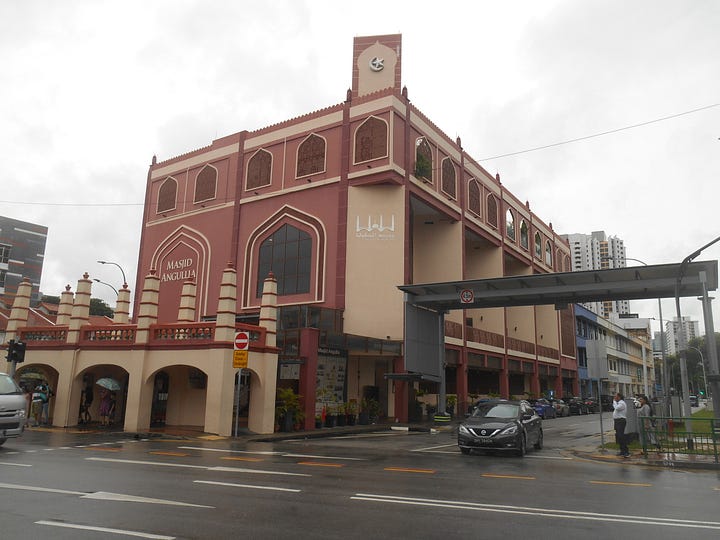
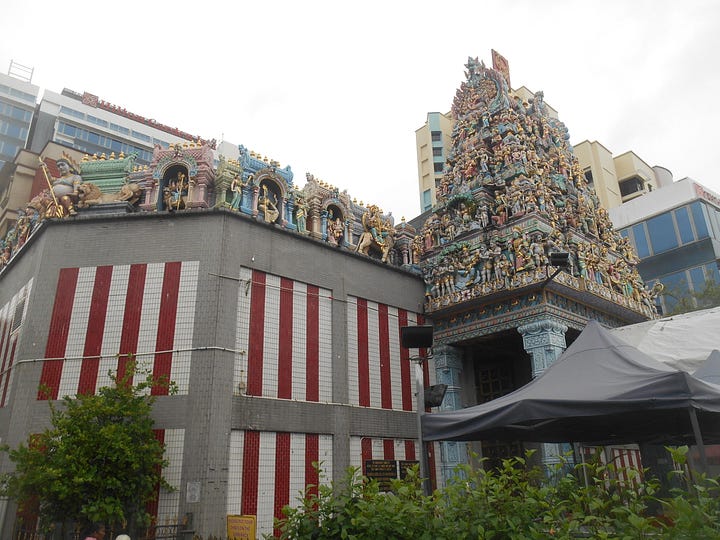
During the conversation, my driver told me how very difficult it is in general—and for non-Chinese foreigners in particular—to acquire Singapore citizenship, irrespective of how long a person has stayed in the city-state as a productive and law-abiding member of Singaporean society. For example, he told me a story about a U.K. woman working as a full-time teacher for over 15 years and who’s been repeatedly denied the opportunity to become a citizen, though the Singapore Government is perfectly happy to grant her Permanent Residency status indefinitely. In light of Vincent’s statement of Singapore’s strong push for rapid expansion of its population, this detail raises interesting questions about the viability of someone like myself who may want to live permanently or long-term in the city-state, regardless of his or her financial net worth or skills-based qualifications that are attractive to the support of Singapore’s societal needs. Certainly, based on all of the desirable traits to be found in Singapore, I can imagine someone becoming frustrated by the arduous process of becoming one of its citizens.
In any event, I soon arrived at my hotel in Little India and that’s where I finally met up with Leng for the first time in over 25 years. While we got caught up on matters of life, we went to a popular Tamil Indian restaurant recommended by her called Machan’s Kitchen (https://www.machanskitchen.com/), located at 74 Race Court Road, Singapore 218574, for an enjoyable and very filling dinner together.
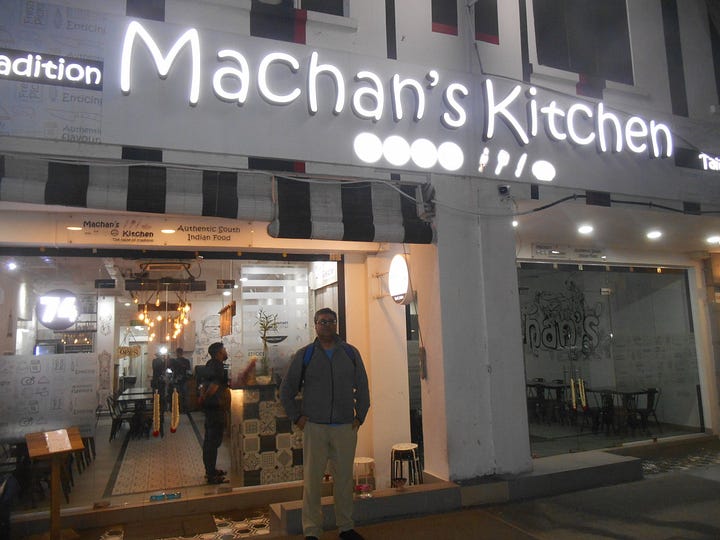
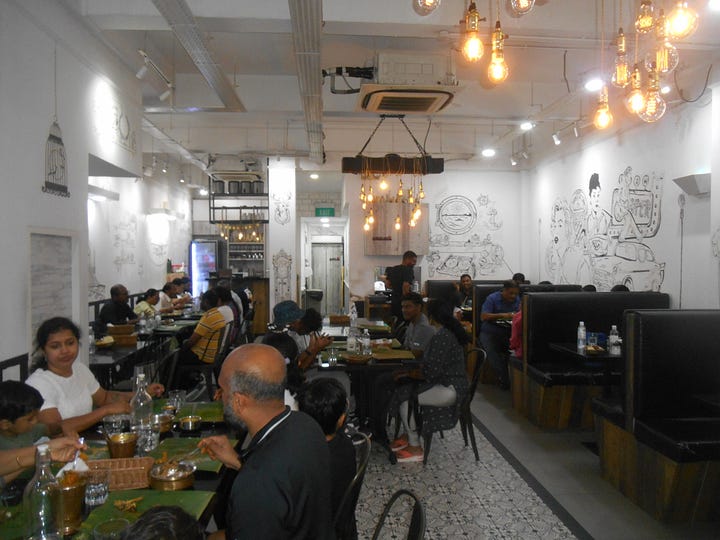
Afterwards, Leng and I took a short walk to a friend’s place nearby where I got a chance to meet casually with some of their mutual friends for an informal get-together that evening. A number of them were from the United States and elsewhere living in Singapore long-term. This gave me an opportunity to ask them about their life experiences in Singapore, including their perspectives on its multicultural makeup, some of the very tough laws against doing small anti-social things like littering, or why it’s extremely difficult for people to become Singaporean citizens that by law requires applicants to give up their previous citizenship. Some of Leng’s friends were very forthright to mention that there’s some favouritism towards ethnically Chinese people, with progressively less favour shown towards the Malay and Tamil ethnicities, in that order.

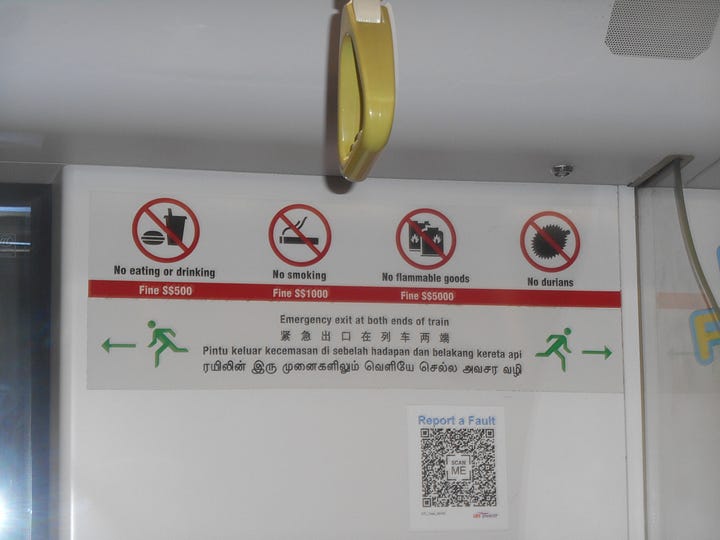
Of course, this discovery is disappointing to learn, and while it’s certainly not reasonable to expect perfection in any country where it concerns the social treatment of its citizens, given all of the positivity I can see in Singapore there are internal issues to overcome over there, as well. As for gaining citizenship in Singapore, it’s also true that for certain people it’s much better for them to remain Permanent Residents for a variety of practical reasons. Whatever the case may be, my sense remains that there’s a lot more positive than negative to be found in Singapore, which is why so many people from outside the city-state are willing to commit whatever time is required to eventually be granted citizenship if that’s their desire.
Changi Airport Revisited Before Going Home
After doing some laundry on Saturday morning and then checking out to eventually reach my airport hotel located one metro stop away from Changi Airport, I prepared myself for the direct flight to Vancouver on Sunday morning. Fortunately, I took advantage of a last-minute opportunity to upgrade my return flight to premium economy, which was probably the smartest travel decision I ever made given the over 14-hour long flight back to Canada.
Once I proceeded into the secure section of the airport at the departure level, I saw for myself the large array of luxury stores and other attractive distractions all over the place, all the while looking for the airport security section to get my belongings scanned. Since my body was feeling sore all over from the fatigue of travel, I was immediately drawn to the idea of getting a back massage before embarking on the flight home. As I had more than enough time available, I was able to commit to getting a much-needed 30-minute back massage before proceeding towards my gate.
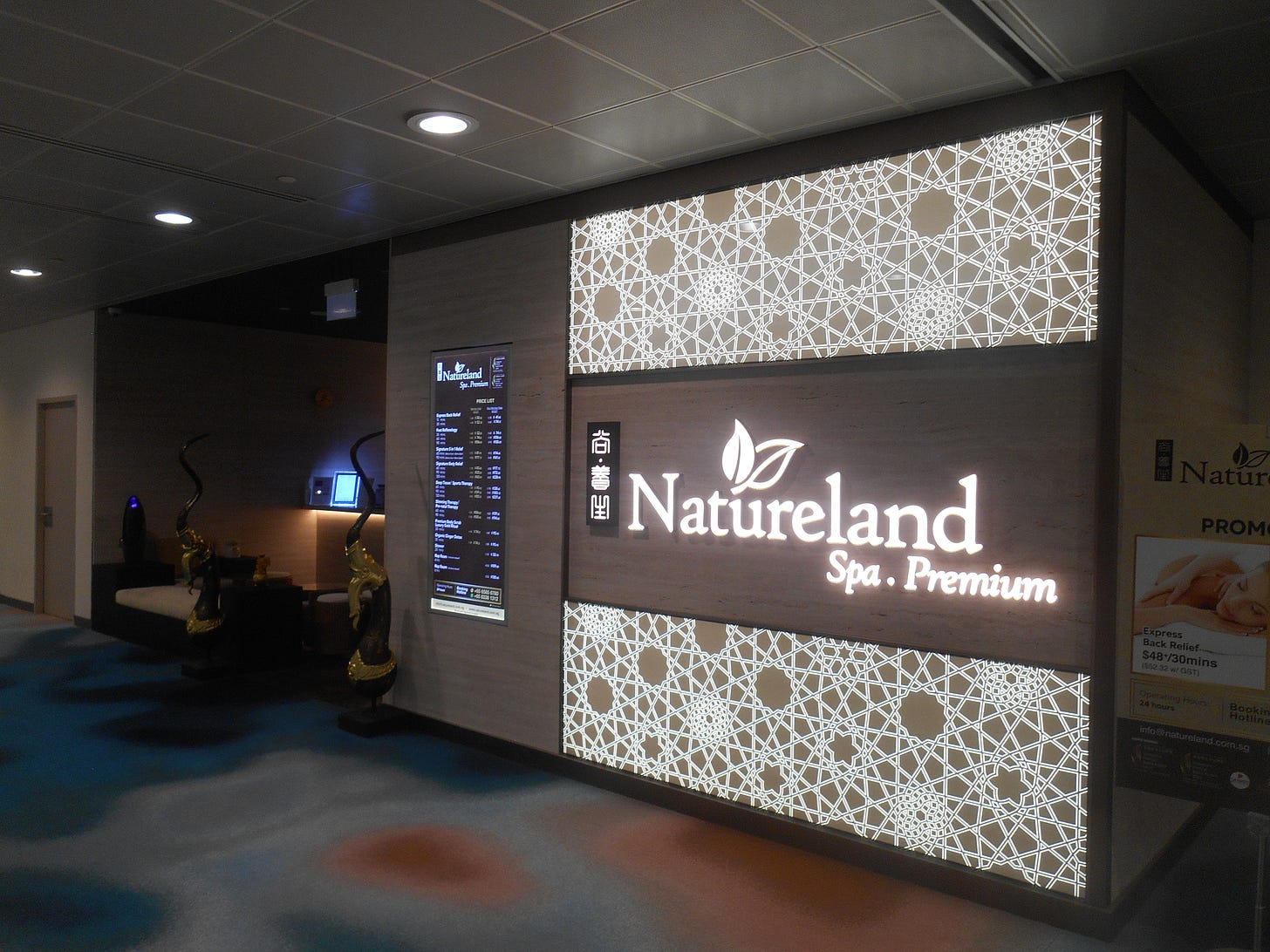
What I discovered to my pleasant confusion is that I managed to reach my gate without finding the typical centralized airport security section for screening! Instead, I came to the realization that at Changi Airport every gate has its own security screening equipment, which means that instead of having a congested—and highly-stressful—location where lots of people are waiting in line to be screened before reaching their respective gates, they arrive at their gates first and then go through screening when it’s time to board the flight. This decision on the part of the Singapore Government to decentralize the security screening makes for a much-improved travel experience overall.
Of course, in order to make that possible, there has to be the willingness to invest in both the necessary security equipment and the overall design of the airport from the beginning to make it a workable proposition. While called up to go through security at the gate, two of the pilots for my flight to Vancouver happened to be immediately behind me, so I had an opportunity to talk with them briefly about what I observed. They told me that it would be prohibitively expensive to implement such a procedure at any of the airports where they fly, particularly a large one like Heathrow Airport in London. Of course, I readily agreed with their assessment, and so this sort of innovation found at Changi Airport is the kind that would be incredibly difficult to replicate elsewhere without causing major disruptions in traffic flow, resulting in more stress to appear during travel instead of alleviating it—at least in the short-term. For myself, this is one more reason to be very impressed by my final experience at Changi Airport before embarking on the journey home.
Concluding Remarks
Having now experienced a first-time visit to Singapore, there’s no doubt whatsoever that I want to go back! That said, because it’s so far away from home there has to be significant justification for me to make the trip again beyond personal interest and connecting with friends like Vincent and Leng. As such, what I can hope for is that Singapore—or a neighbouring country in southeast Asia—presents more professional opportunities for me to make it possible to commit to such a return in the near future. Should that arise, then I would easily make an effort to stay longer than a day or two to take in the abundance of sights, sounds, and tastes that Singapore offers its visitors for any duration—with some of them to even want to stay there for good!
Source:
Inside Singapore's Most Luxurious Casino Resort | Megastructures: Singapore's Vegas | Spark




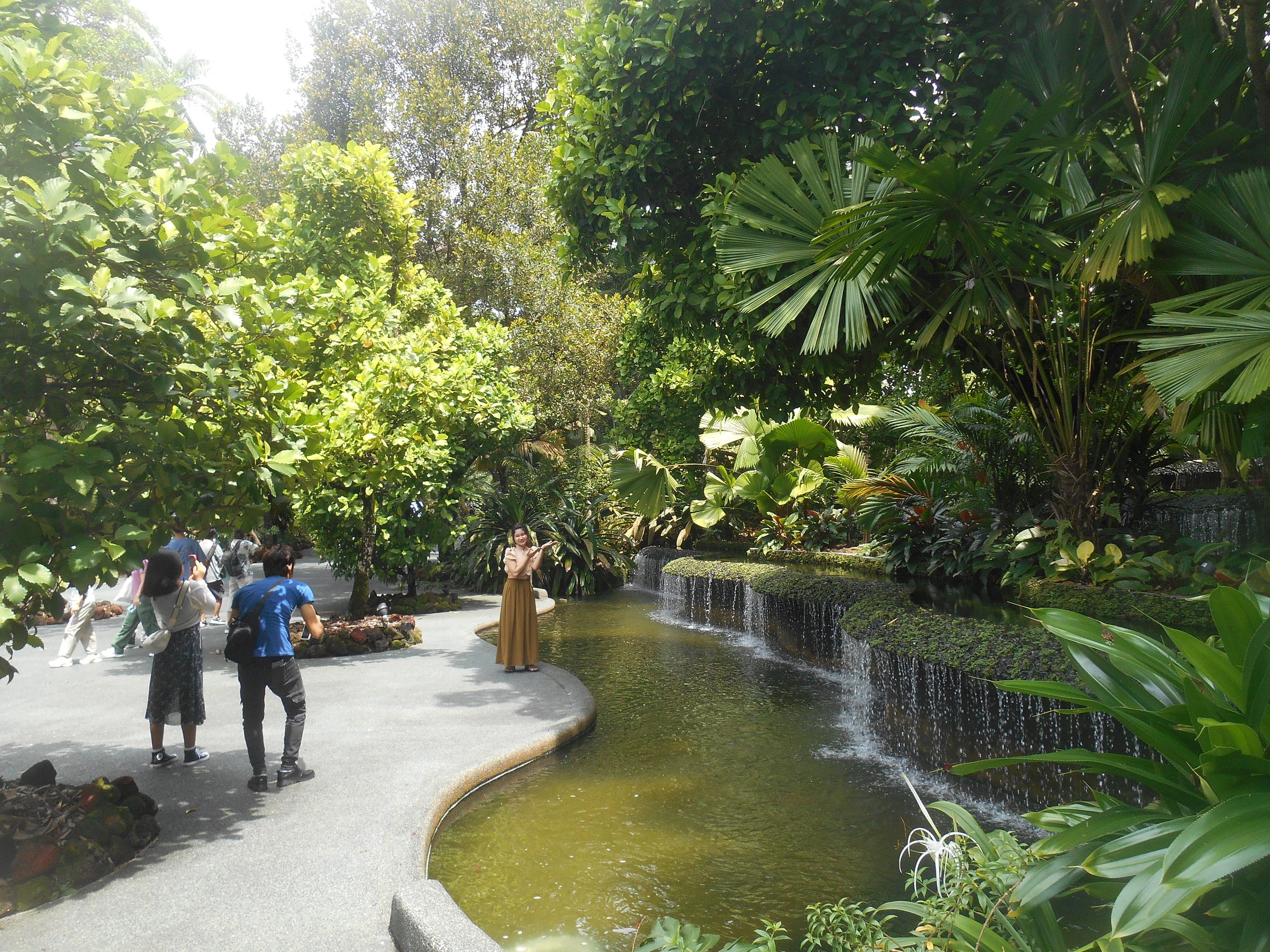
Hi. Please feel free to comment on this article anytime if you like what I've written or have anything constructive to add. Also, please take a moment to check out my "About" page and become a free subscriber to "Scientist World Traveller" if you haven't already done so. Thank you.